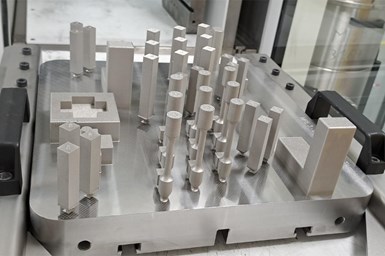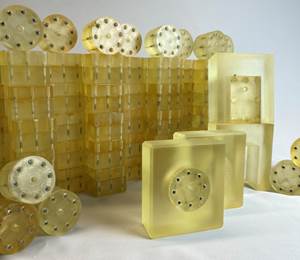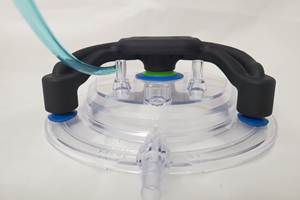AddUp, SSG to Introduce Tool Steel Optimized for Injection Molding Applications in Additive Manufacturing
SSG developed the Printdur HCT material to meet the requirements of injection molding, enabling manufacturers to significantly reduce production cycles using conformal cooling channels.
AddUp will soon be releasing Printdur HCT, a tool steel optimized for injection molding that meets all customer requirements such as corrosion resistance, hardness and wear resistance for injection molding applications.
The Printdur HCT was developed by Swiss Steel Group (SSG) based on the conventional standard tool steel 1.2083/AISI420 tailored for additive manufacturing (AM) with focus on powder bed fusion machines like AddUp’s FormUp 350. Following strict internal manufacturing readiness level protocols AddUp’s engineers were able to achieve up to 50% improvement in build speed without cracks and extremely low porosity, ensuring over 99.90% material density when compared to the standard material.
The company also says surfaces can be built up in excellent quality and without any smoke residue. The Printdur HCT material was designed for the requirements of injection molding and can significantly reduce production cycles using conformal cooling channels. Most of the internal cooling channels can be optimally built to a sufficiently good quality, without any support structures.
AddUp says it is committed to developing new materials for the tooling market and was excited to partner with SSG, one of the world’s producers of special steel long products, to collaborate on the development of Printdur HCT.
“Our goal is to use our decades of experience in the atomization and materials technology to design new materials for additive manufacturing,” says Dr. Horst Hill, head of the Special Materials Division at SSG. “The Printdur HCT utilizes the advantages of additive manufacturing to achieve the best material properties. We are very pleased that we have found a strong partner in the tooling sector in AddUp to establish new materials on the market.”
Because of an enhanced hardness range of 53-57 HRC and high wear resistance Printdur HCT offers an improved and longer service life for the mold inserts. With simple one-step heat treatment at 540°C, Printdur HCT achieves ~53HRC hardness and is ready to be used for injection molding applications because the material can withstand high temperatures without losing hardness.
Because the material is produced without nickel and cobalt, significant damage to the environment and the operator could be avoided. SSG, this year's winner of the German Sustainability Award, says it consciously focuses on high sustainability standards with its fully comprehensive powder recycling system. It is also one of the few companies that can already supply almost all products with a significantly reduced CO2 footprint as Green Steel. This has a particularly positive effect on the CO2 impact of its customers in Scope 3.
AddUp’s goal is to revolutionize injection molding applications and improve the efficiency of molds using AM. It expects the development of Printdur HCT and other tooling specific materials in its portfolio to support this mission. “At AddUp, we are committed to taking tooling molds to the next level using the FormUp 350,” says Julien Marcilly, AddUp CEO. “Our company’s history is deeply rooted in tooling applications thanks to our founding partners Michelin and Fives. It is through our experience and expertise in this industry that we continue to push the possibilities of additive manufacturing, proving it a more efficient and productive way to manufacture on an industrial scale.”
Printdur HCT’s manufacturing readiness level 3 has been achieved, which makes it ready for producing high quality proof of concepts. Currently being used on the FormUp 350 machine located at AddUp’s Tooling Competence Centre in Aachen, Germany, Printdur HCT is immediately available for prototyping and once fully developed will be available for end-use production parts.
Related Content
The Connector Conundrum: 3D Printed Mold Tooling’s Role in Innovation
ReelView Fishing faced an electronics obstacle in the development of its new technology for underwater video. Additive manufacturing for moldmaking allowed for the speed necessary to iterate to a solution. How inventors and invention will benefit from new ways of obtaining production-ready tooling.
Read More3D Printed Mold Tooling Advances in Performance With Proprietary Resin
Material improvements offer turnkey production and cost trimming with 3D printed mold tooling. A new, proprietary resin addresses the current limitations associated with 3D printing in polymer.
Read MoreIn "Hybrid" FIM Process, 3D Printing Complements Injection Molding
In a recent case study, Alpine Advanced Materials partnered with Nexa3D to produce 3D printed tooling for injection molded composites. Utilizing Nexa3D’s XiP desktop 3D printer and its Freeform Injection Molding process, Alpine was able to reduce prototype tooling production time and cost alike for its customers.
Read More8 Ways the Plastics Industry Is Using 3D Printing
Plastics processors are finding applications for 3D printing around the plant and across the supply chain. Here are 8 examples.
Read MoreRead Next
Postprocessing Steps and Costs for Metal 3D Printing
When your metal part is done 3D printing, you just pull it out of the machine and start using it, right? Not exactly.
Read MoreAlquist 3D Looks Toward a Carbon-Sequestering Future with 3D Printed Infrastructure
The Colorado startup aims to reduce the carbon footprint of new buildings, homes and city infrastructure with robotic 3D printing and a specialized geopolymer material.
Read More3D Printed Polymer EOAT Increases Safety of Cobots
Contract manufacturer Anubis 3D applies polymer 3D printing processes to manufacture cobot tooling that is lightweight, smooth and safer for human interaction.
Read More





















